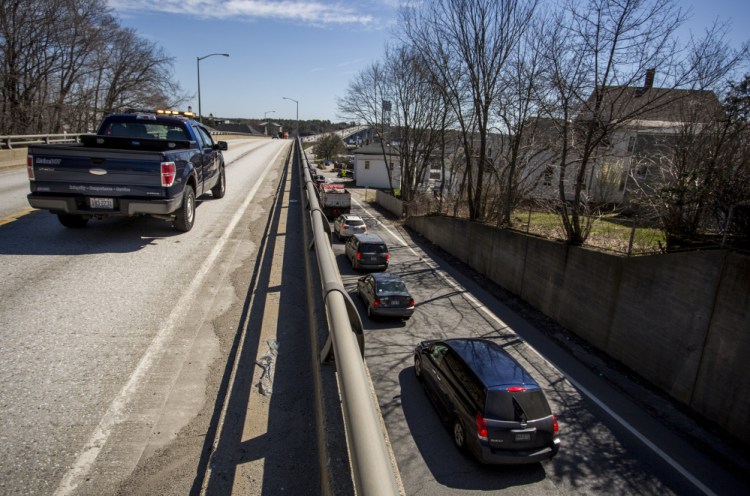Maine’s Department of Transportation failed to repair guardrails on the aging Bath Viaduct despite two damning inspection reports submitted to the state since 2014, one of which called for immediate repairs.
The guardrails, some of which are missing bolts attaching them to the concrete, did not prevent an SUV holding a mother and her child from crashing through and falling 40 feet to the street below.
Only after the Portland Press Herald examined the viaduct and found several dozen missing or broken bridge rail bolts on the 58-year-old span did state officials order a closer examination of the Bath Viaduct railings and the roughly 30 other bridges in the state that share that railing design.
After the newspaper’s examination, the agency also suggested for the first time Thursday that the state may retrofit old and untested bridge railings of the same design that do not meet current crash standards.
The rapid about-face came after the newspaper asked about deficiencies in the railings following the April 4 crash in which Melissa Medina, 37, with her 12-year-old son in the car, lost control of her vehicle, struck the viaduct’s railing at about 35 mph, broke through and plummeted into the bed of a pickup truck on the road below, according to police. The speed limit on the viaduct is 35 mph.

A newspaper examination of the Bath Viaduct after an SUV crashed through a section of railing found that of the 1,536 anchor bolts for the rail posts, 87 were sheared off, had missing nuts or were damaged. Photo by Matt Byrne/Staff Writer
The railings and bridge were installed in 1958, decades before cars and highway safety equipment were required to undergo crash testing. The bridge now carries more than 18,000 vehicles per day, according to the state.
While the railings along bridges and overpasses are technically known as bridge rails, the public also commonly calls them guardrails.
Although state road crews quickly repaired the section of bridge rail that was broken in the crash, the Press Herald did an independent examination of the rest of the viaduct railing a week later and found:
• Of the 1,536 anchor bolts that secure the rail posts to the concrete, 87 were sheared off, had missing nuts or were damaged.
• In six areas along the viaduct, damage was visible on multiple consecutive railing posts, which are spaced roughly 6 feet apart.
• Some of the aluminum anchor nuts were badly corroded and crumbling.
• While there are supposed to be four bolts per post, a total of 16 posts on the viaduct had more than one fastener damaged or missing.
• Two posts had only one bolt holding that portion of the guardrail to the concrete.

A guardrail support post is cracked and a nut is missing from the bolt at right on the Bath Viaduct. A 2014 inspection by a private contractor suggested that the Maine DOT repair the viaduct railing in six places. Gabe Souza/Staff Photographer
When asked about these findings in an April 14 interview, top transportation officials admitted that although a bridge inspector in January noted a “scattered” number of nuts and bolts missing from the guardrails, the agency never counted how many fasteners were broken or damaged. The officials also said they did not know how many missing bolts would be enough to trigger immediate repairs.
One day later, the state undertook a count and closer examination of the Bath Viaduct. The department’s own review found 39 bolts were sheared off or missing, 34 nuts were gone from their bolts, and 24 railing posts showed signs of damage. Overall, inspectors said the bridge rails were found to be in good condition and did not warrant immediate action.
On Tuesday, inspectors examined 31 other spans around Maine that have a similar railing design, officials said.
On Thursday, state officials said the inspections are pending and that retrofitting the bridge rails is being considered.
Emergency Bridge Inspections
After a guard rail failed on the Bath Viaduct this month, the state is rushing to inspect the state’s 30 other bridges that have a similar design.
Joyce Taylor, the agency’s chief engineer, stressed that it is important to evaluate a bridge and its components as a whole, and pointed out that guardrails are not a guarantee of safety on roads. Although new guardrails are crash-tested, that does not mean they are guaranteed to contain every crash.
“One of the things that’s important to know, if guardrails and bridge rails were really 100 percent all the time going to save someone or keep them (out of) harm’s way, we’d have guardrails from one end of the interstate to another,” Taylor said. “Things happen sometimes. I’ve seen guardrails (get) hit and it worked exactly the way it’s supposed to work. We’ve seen other hits where people are seriously injured and you can’t quite figure it out. It’s not a 100 percent solution, and it’s important that we stress that people have to be aware of conditions they’re driving in, being aware of taking that responsibility when you’re behind the wheel. It’s not 100 percent that we can say you’re going to be safe because of a guardrail or bridge rail.”
ASSESSING WHEN SAFETY COMPROMISED
Taylor said data on previous crashes along the Bath Viaduct show that before the one in April, the railing had contained the vehicles in each of the last eight major crashes from 1960 to 2005.
“That would give us some confidence that this system wouldn’t need to be replaced, knowing that (there is) a coming bridge replacement,” she said.

The SUV that crashed through the Bath Viaduct safety railing April 4 sits in the roadway below. Jill Brady/Staff Photographer
William Williams, a structural engineer at Texas A&M University and a leading expert on updating old bridge rails to modern standards, said it would be difficult for him to determine, without testing and in-person evaluation, how many missing bolts would compromise a bridge rail. Typically, bridge designers add extra strength beyond what is called for, giving an added safety factor if bolts break or loosen during decades of service. Simply because a structure is old does not mean that it is necessarily weak or deficient, he said.
“There’s still a lot of aging infrastructure out there that’s still (operating) well above capacity,” Williams said. “It is still functioning to serve the requirements of today.”
Ben Foster, the DOT’s assistant bridge maintenance engineer, said Thursday there is no hard and fast rule for replacing missing hardware, and that every situation is evaluated on a case-by-case basis.
“There is no standard guideline (for) bolts missing or damaged (nuts),” Foster said. “It’s an engineering judgment.”
However, an August 2014 inspection done for the Maine DOT by a private contractor, HNTB of Westbrook, suggested in a section of the report headed “Action required” that the state repair the missing railing bolts and damaged railing posts at six locations on the viaduct, in addition to other suggested fixes.
After it was inspected again in January, this time by a state employee, the bridge rail was listed as having “scattered” missing bolts, and the report found that only 6 feet of the nearly 2,600 feet of railing was in poor condition. That report did not note where on the bridge the damage was located, or include a count of the number of missing or damaged bolts.
ANALYZING RISK, EXTRA INSPECTIONS
Despite the reports, the state did no maintenance on the viaduct bridge rails in the past two years, looking instead to a full replacement of the structure. That project is scheduled to begin this year, at a cost of $15 million, and be completed in 2017.

Taylor also said in the April 14 interview that there is no statewide policy governing whether guardrails or bridge rails installed in the 1950s, ’60s or ’70s – when there were no mandatory crash-testing standards – should be replaced to meet current standards.
“We take more of a data-driven approach and are looking at where we think our real risk is,” Taylor said. As an example of that strategy, Taylor said, the agency identified head-on collisions as a major risk to Maine motorists, so the agency is installing rumble strips and steel cable guardrail on state roads and major highways where there was nothing to stop a car from crossing into oncoming traffic.
To address further concerns, the agency held a news conference Thursday at the Bath Viaduct, where Taylor and Foster, the bridge maintenance engineer, led a group of reporters along the viaduct to explain how each element is inspected. Both Taylor and Foster reiterated that although Maine, like most states, is under pressure to extend the life of its infrastructure, travel on state highways and bridges today is safe.
Foster said Thursday that the viaduct has been inspected annually instead of every other year because the state knew it was in rough shape.
“We’ve made sure we inspected it once every inspection cycle every year,” Foster said. “That way we’ve had more eyes on it.”
A total of seven inspectors and several private companies under contract are responsible for examining nearly 3,900 bridges in Maine every year or two, depending on their condition, ranging from small culverts to “forever bridges” that the state expects to last a century or longer.
Foster then reviews every bridge inspection report, some 2,000 each year, to prioritize which bridges will receive immediate attention. He does this without the assistance of other people or computers, he said.
Asked if he felt overworked, Foster said no.
“There’s always been one person,” he said.
Send questions/comments to the editors.





Comments are no longer available on this story